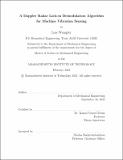A Doppler Radar Lock-in Demodulation Algorithm for Machine Vibration Sensing
Author(s)
Wampler, Lois
DownloadThesis PDF (1.618Mb)
Advisor
Youcef-, Kamal
Terms of use
Metadata
Show full item recordAbstract
Data-driven predictive maintenance of modern machinery has the potential to increase equipment lifespan and decrease manufacturing costs. Among various condition monitoring techniques, vibration analysis can effectively diagnose potential problems in machines. Doppler radar can be used as a sensor that provides non-contact, inexpensive real-time data collection without necessitating line-down time. Conventional Fast Fourier Transformation based vibration analysis requires large amounts of data to achieve high spectral resolution necessary for fault detection especially with radio frequency sampling, which can be computationally too expensive for analysis. In this work, we propose to use a sweeping lock-in amplifier to achieve high frequency resolution with small amounts of data by processing windowed sections of Doppler-shifted radio signals. This algorithm can reliably measure the Doppler shift frequency corresponding to the travelling speed of a low frequency moving object and identify the oscillation frequency with small amplitude, with the latter widely present in machine vibration. The distinguishing condition of the two cases is mathematically derived. The proposed algorithms are verified in simulation with triangular displacement waveform for simplicity of analysis and sinusoidal waveform for generic applications. For experimental verification, speaker vibration at a known frequency is analyzed to achieve an accuracy of 0.025 Hz within the known vibration frequency. This method is robust to the presence of noise frequencies and capable of detecting multiple frequencies.
Date issued
2023-02Department
Massachusetts Institute of Technology. Department of Mechanical EngineeringPublisher
Massachusetts Institute of Technology